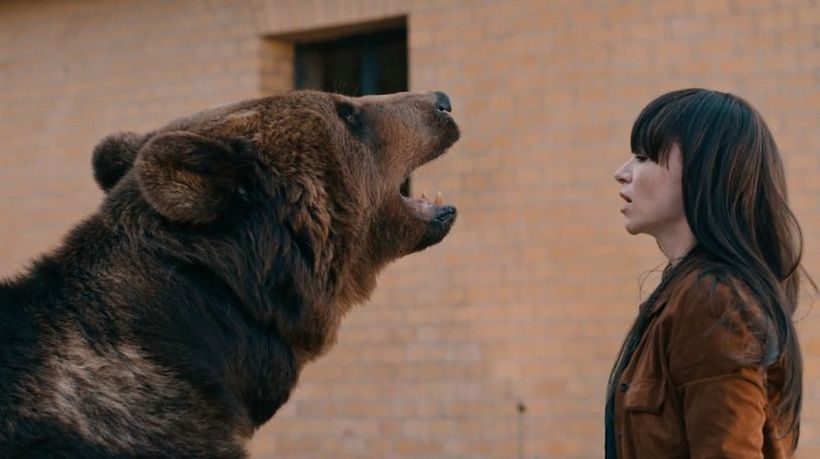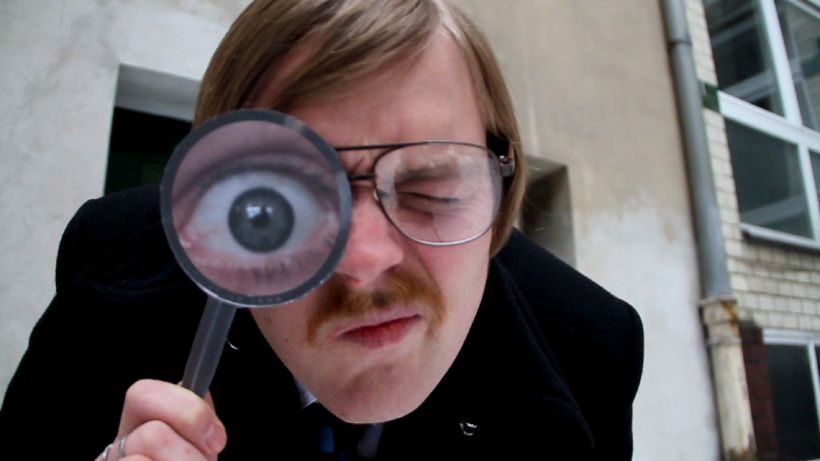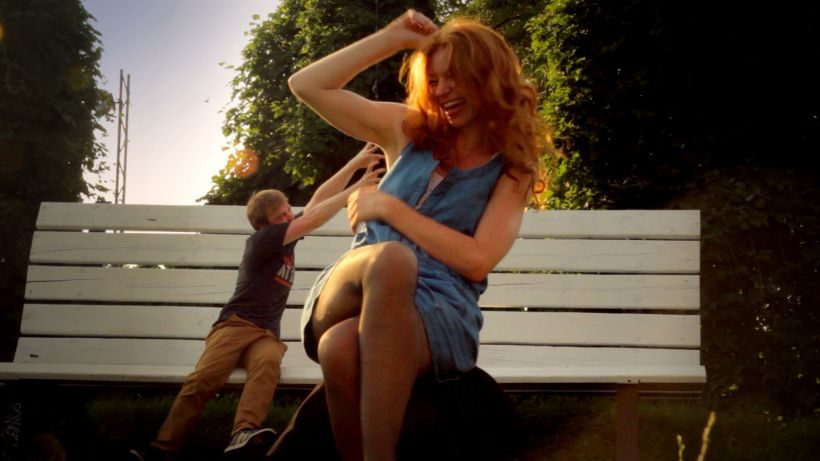
Berlin Metanoia © KurzFilmAgentur Hamburg
Just the first few seconds of this film are enough to create an all-pervading sense of oppression that predominates for the next 15 minutes. “Berlin Metanoia” is a dark, almost (hellishly) dreamlike trip into the innermost realms of a city that loves to market itself as young and cool, but which has lost its soul somewhere between hipsterism, tourist onslaughts and hype. In his latest short fiction film, which celebrated its premiere at the 2016 Berlinale, Erik Schmitt approaches the latent psychotic Berliner identity with an intensity that continues to reverberate for a long time afterwards.
Kore (Marleen Lohse) feels the pressure hanging over the city like a dark cloud more acutely than most other people. In a husky voice, she describes how the shackles of fear are constricting her soul and dread is penetrating to the fore from her subconscious mind. However, other people living in the city are also experiencing how their levels of consciousness are not separating clearly from each other all of a sudden and the borderlines between dreams and reality are becoming blurred. When, on top of all that, a bear escapes from its pound, the whole city succumbs to panic. Kore is ultimately the only one who faces her own fears.
Not only does “Berlin Metanoia” play masterfully with the linking of differing narrative strands, it also works with subliminal sounds that cause an unease to slink into our guts, with the contrapuntal editing of the images and the soundtrack, and especially with the language itself. The central figure Kore is employed as a voice-over artist. Cooped up in a gloomy recording booth, the seemingly distraught young woman tries to accord the exact same sentences new levels of meaning through differing intonations and articulations. The leading actress Marleen Lohse, who has worked together with Schmitt on a regular basis for several years, is allowed to reveal completely new sides to herself here. She brands the film with her rough, vulnerable voice, which is so present like in none of the other films they made together before, as it holds together the individual scenes.
“For me, every one of my short films is like a self-organised course of studies on a specific area. In “Berlin Metanoia”, we wanted to explore how stories can be told without a fixed narrative framework. We wanted to tell differing dreamlike stories that are only loosely connected to each other. With the fragments acquiring a consistency through Kore’s voice especially.”
“Berlin Metanoia” is the last part in a trilogy, of which the first part was produced in 2013. However, Schmitt’s career as a director goes back beyond this. He shot his first short films under the Kamerapferd label. Together with Stephan Müller, who was also portrayed in this series in 2006 (http://www.shortfilm.de/stephan-flint-mueller/), they made several prize-winning films between 2009 and 2014, all of which play with our sense of perception and leave it feeling unsettled through a mixture of optical tricks and analogue in-scene animations. Doing so, the two filmmakers do not act like magicians trying to visually hoodwink their audiences, but rather like mischievous movie jesters who unmask their own illusions in the next breath to be what they are: Creative optical conjuring tricks that pay a most pleasant homage to the analogue in an era of digital animation and postproduction.
Borne by the desire to experiment, the Kamerapferd films and clips repeatedly explore the possibilities of the visual narrative anew. Their earlier joint works especially are marked by animation tricks and a highly experimental approach. Various camera tricks are skilfully collaged in “Fliegenpflicht für Quadratköpfe/Bow Tie Duty for Squareheads” (2004), yet the film itself gets by without a firm storyline strictly speaking. The fake-docu “Nicht nur der Himmel ist blau/How to Fly High” (2009) was produced during a 48-hour film festival by taking a spontaneous idea and without any long planning or research. The short film “Nun sehen Sie Folgendes/Now See the Following”, which was made in 2010, was not even intended as a film in its own right, but rather the result of a creative camera test. In order to conduct the test under the most realistic conditions possible (and with as much fun as possible), the film crew devised the simplest of screenplays with a looney main character, an evil secondary character, a blonde beauty and a granny waiting for her grandchild. This modern Little-Red-Riding-Hood tale was shot in the shortest of time and feels like a not quite seriously intended guide for budding filmmakers.
When Kamerapferd won the German Short Film Prize completely by surprise with “Nun sehen Sie Folgendes” in 2011, Schmitt and Müller were flabbergasted. With the unexpected Lola Award under their belts, entirely new opportunities suddenly opened up for them. They immersed themselves in the German short film scene, and realised that there really are structures and networks which attain on a completely official and professional level what they had regarded up to then as being “merely” a much treasured recreational hobby for them. The following year, they flew to Los Angeles together, where they intended to plan their next project as fellowship recipients in the Villa Aurora.

Nun sehen Sie Folgendes © KurzFilmAgentur Hamburg
In retrospect, Erik Schmitt describes the work done together with Stephan Müller as a stroke of good fortune and an absolutely formative phase:
“Before I met Stephan, I was always alone with all my crazy ideas. But suddenly someone was there with whom I had an intuitive understanding and who went far further in his experiments. Working together with him was amazing. Although I wouldn’t really say it was “work” at all, to be honest. We simply headed off into the city and practiced looking at it in an attentive way and seeing it with a different eye. We had lots of time, hardly any money, no commissions, but heaps of fun.”
Thus to a certain extent, Kamerapferd simply embodied the myth of the creative capital of Berlin, which would ultimately continue to play a major role in the subsequent films by Erik Schmitt.
Their stay in Villa Aurora turned out differently to what they had planned, and became a watershed in the directing duo’s relationship. Although two short films (“Somewhere Else” and “Ich schweife ab/I Digress” – both 2013) were shot during their three-month residence, it became evident in the USA that their shared productive era was now coming to an end. Ultimately, Erik Schmitt took over the directing and completed the ambitious short fiction film about the soul of a city alone, which was initially intended as a project from both of them. Despite their decision at that time not to shoot any more films as a double-director team, they have both been happy to support each other in their various individual projects up to the present day.
While “Nashorn im Galopp/Rhino Full Throttle” (2013) was originally based on a joint plan from both of them, in the end Erik Schmitt filmed it as the sole director over just eight days of shooting at the height of summer in Berlin. Through her forceful presence, Marleen Lohse defines the film, which is a declaration of love to her role of “Vicky” and at the same time to the city of Berlin. Here too – like many other members of the team – she is a party to the events unfolding in the film, as she is in the other two parts of the trilogy. The film recounts a summer story of love, letting go and seeking out the soul of the city. Its artistic emphasis is found in the most diverse kinds of analogue animation utilised in the film, through which the viewer’s eyes are opened up to the countless faces of the metropolis. With tricks of perspective alternating in fast sequences with stop-motion animation scenes and street art elements. Doing so, the focus is on the cautiously developing love story between the maverick loner Bruno and the charismatic globetrotter Vicky on the one hand and, on the other hand, on the city itself, whose small and large idiosyncrasies Erik Schmitt stages skilfully (accompanied by an excellent soundtrack). To a large extent, the film foregoes classic enacted scenes, with the plot advancing especially through Bruno’s off-screen commentary.

Nashorn im Galopp © KurzFilmAgentur Hamburg
“With this film, I wanted to try and see how various animation elements can be welded together into a strict storyline. So it seemed logical not to consider the visual perception of the city solely as a formal experiment, but to also extend this into the film’s subject matter. My characters are urban saunterers – like I myself was at that time – who are not working towards a specific aim, and instead turn the act of seeking into the filmic event.”
Evidently the film was on the pulse of the times, as it became an unexpected international success. “Nashorn im Galopp” went on to win over 50 prizes and awards at more than 100 festivals. But instead of taking this as a reason to serve up what was obviously a good filmic recipe once more, Erik Schmitt chose a completely different focal point for his next project.
In “Forever over” (2014), he does indeed reassemble the same cast who were filmed over large parts of “Nashorn im Galopp”. Here, however, the characters of the roles are changed, as well as the emphasis accorded to the cinematic means. Schmitt recounts the story of a relationship that has grown staid over time. Mia and Tom want to reenergise their love by setting themselves the task of helping the other one fulfil their dreams, regardless of what this entails. A story evolves from this experimental process, over the course of which – despite all their efforts – they gradually become more and more emotionally distant from each other. Instead of availing once more of animation sequences (which are, however, still found here in measured doses), centre stage is accorded to the unfolding drama here. Through minor gestures, vocal nuances and looks cast into emptiness by the main characters, it progressively becomes ever clearer that this relationship cannot be saved anymore.
“With this film, I wanted to learn how a director works with actors, how feelings can be expressed and types of people staged or enacted. Of course I was no less interested in the animated sequences because of this. But I did quite clearly focus on a new aspect here. After all, I had just explored the potential offered by analogue animation in the film I made just before this. For me, my short films were simply a kind of DIY film school. With each film set under a different heading.”
Schmitt has now completed the third and final part of his Berlin trilogy with “Berlin Metanoia”. In this case, as mentioned above, he concentrated more on the visual composition and design, as well as on working with a more complex, non-linear narrative form. But this certainly does not mean that his exploration of the subjects of love, the city and perception has now come to an end. Together with his film family that has grown over the last few years, Schmitt has just shot the feature film “Story of Berlin” in which not only today’s Berlin plays a leading role, but also the complex history of the city. When we requested an interview with him during the middle of the editing, he was, on the one hand, proud and happy to now have his first full-length feature film in the can. On the other hand, however, he also realises that in his case the feature-length film format will not completely replace short film. For him, short films will always remain an essential means of expression, as only they permit him to react quickly, spontaneously and creatively and to apply himself to experimentation without long planning phases.
This is exactly what he did most recently in “Santa Maria”, a film-noir miniature running just under 5 minutes that was produced explicitly in a 9:16 format for viewing on mobile phones. The film is edited fast, told in a stylistically confident and humorous way, and one of the first short films from Germany that makes intelligent use of the vertical perspective. The project, which was produced thanks to a commercial sponsor, won the 2017 Short Tiger Award, among others. It is now available for booking as a supporting film in cinemas.
Thus, Erik Schmitt continues to remain loyal to the short film metier. Every single film is like a small piece of art that at their best works like the song “Bohemian Rhapsody” by Queen: Full of unique and surprising individual components that still manage to join together in the end and form a perfect whole.
Filmography
2016 Santa Maria – Director, Screenplay
2015/2016 Berlin Metanoia – Director, Screenplay
2014 Forever Over – Director, Screenplay, Editing
2013/2014 Telekommando / Telecommando – Director, Screenplay
2013 Ich Schweife Ab! / I Digress – Director, Screenplay, Producer
2013 Somewhere Else (https://vimeo.com/51279340)
Director, Screenplay, Producer
2012/2013 Nashorn im Galopp / Rhino Full Throttle – Director, Screenplay, Editing
2010-2012 Weil ich schöner bin / Because I’m More Beautiful – Animation
2010 Nun sehen Sie Folgendes / Now See the Following – Director, Screenplay, Cameraman
2009 Nicht nur der Himmel ist blau / How to Fly High – Director, Screenplay, Cameraman
2007-2010 Solartaxi – Um die Welt mit der Kraft der Sonne / Solar Taxi – Around the World with the Power of the Sun Director, Screenplay, Cameraman, Producer